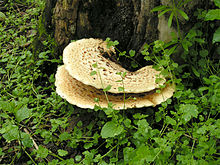Cerioporus squamosus
Dryad's Saddle (Polyporus squamosus) is an edible basidiomycete mushroom found in the genus Polyporus. The name "Dryad's Saddle" refers to creatures in Greek Mythology called Dryads who could conceivably fit and ride on this mushroom. Alternatively, confused animal hunters have called it "pheasant's back mushroom" due to the similarity to a pheasant from a distance.

Distribution and Life
This organism is common and widespread, being found west of the Rocky Mountains in the United States and over much of Western Europe. It commonly fruits in the spring, occasionally during autumn and rarely during other seasons. Many mushroom hunters will stumble upon this when looking for Morels during the spring as both have similar fruiting times and this fungus will grow to a noticeable size of up to 2 feet across. It plays an important role in woodland ecosystems by decomposing wood, usually elm, but is occasionally a parasite on living trees. It is especially interesting as it can digest lignin.
Physical Characteristics
This mushroom is commonly attatched to dead logs or stumps at one point with a thick stem. Generally, the fruiting body is 3-12 inches across and up to 4 inches thick. The body can be yellow to brown and has "squamules" or scales on it's upper side. On the underside one can see the pores that are characteristic of the genus Polyporus that if layed onto a sheet a paper will produce a white spore print. They can be found alone, in clusters of two or three, or forming shelves. Young specimens are soft but toughen with age.
Edibility and Human Uses
While Dryad's Saddle certainly is not poisonous, it is generally not prized as an edible. Cookbooks dealing with preparation generally recommend gathering these while young, slicing them into small pieces, and cooking over low heat. Most people find the "mealy" favor displeasing, although this is not a universal sentiment. More people value the thick, stiff paper that can be made from this and many other mushrooms of the genus Polyporus.
